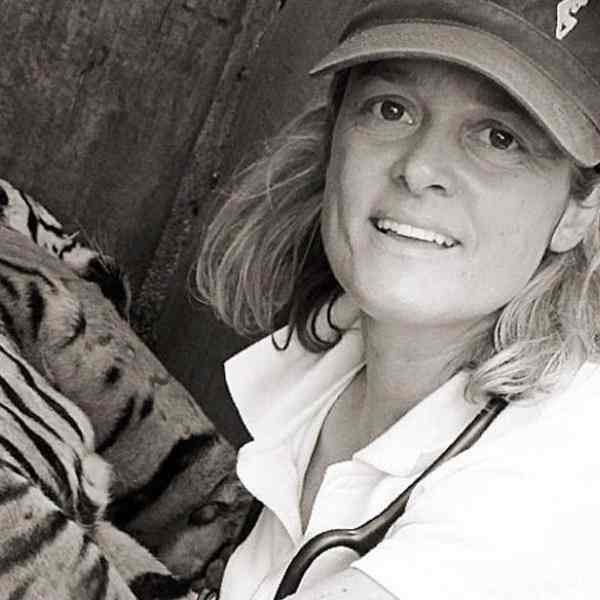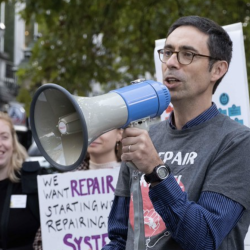Introduction
Dr. Deborah McCauley is building a health care system for endangered animals in the Himalayan belt.
The New Idea
For years, tremendous efforts – and millions of dollars – have been invested to protect critical habitat, reduce wildlife trade and poaching, and educate communities. However, conservation efforts have overlooked one of the most important factors - wildlife health. Wildlife health is the missing piece in the global conservation strategy. Many of our most magnificent fragile and endangered animals, like the Bengal tiger or Asian One-horned rhino, continue to struggle for survival. Their future will remain precarious unless and until we ensure, that the species we are protecting are healthy. VIEW (Veterinary Initiative for Endangered Wildlife) was founded to protect endangered wildlife by tackling the health threats they face in their native habitat.
Globally, endangered species are in steep decline. Unless we use other techniques to approach this threat, our most iconic species will no longer exist for future generations. Dr. Deborah McCauley started VIEW in Chitwan National Park (CNP), Nepal. Nepal holds great pride in representing one of the world’s richest areas in diverse wildlife species and has reserves that hold 28% of their surface for wildlife and biodiversity conservation. The world heritage Chitwan National Park houses some of the rarest species on earth, from Bengal tigers and Asian One-horned rhinos to Asian elephants.
Nepal also boasts successful anti-poaching efforts, which have drastically reduced the number of animals poached. Nepal’s rich biodiversity, however, is tenuously balancing against the encroachment of humans (29 million people), domestic animals (5.8 animals per household) and their pathogens (disease inducing heath threats), along with the ever-present threat of climate change.
Dr. McCauley founded VIEW, the first conservation organization solely focused on the urgent need to address health threats as a comprehensive strategy for protecting endangered wildlife. It has been well documented that endangered wildlife species share diseases with domestic animals and people. In zoos and captive settings globally, veterinarians have successfully prevented and treated endangered wildlife from disease and illness by applying best practices in diagnostics, treatment, and management. This proven approach can also be applied in the field to our free-roaming wildlife. The veterinary and medical communities have the tools, technology, and expertise to help our most fragile populations. VIEW is on the frontlines, applying known science and established best practices to build sustainable wildlife health programs that are scalable and replicable. In Nepal, VIEW has worked with local and global partners to include wildlife health in local conservation efforts.
VIEW was also founded on the desire to not only help the wildlife of Nepal but to build a template that can be replicated nationally and globally. With strategic partnerships at the local and national levels, VIEW has built a Wildlife Health Program in Chitwan National Park, from which Protected Areas across Nepal and other countries can use and create as a template.
The Problem
On a global scale, various diseases are having a strong impact on critically endangered wildlife (NWF.org), fueled by habitat encroachment by humans and animals sharing the land. As a result, they are also transmitting pathogens, while climate change exacerbates this detrimental environment.
Among the cases finally studied, Canine Distemper Virus (CDV) for instance, this has caused population collapse and near extinction of Wild dogs, Black footed ferrets, and Swift fox populations. In addition, fragile carnivore species such as Red pandas, Snow leopards, Clouded leopards, bears, Giant pandas, River dolphins, and tigers, are all highly sensitive to CDV (WCSV.org). Deeper yet, given that 60% of all human diseases are shared with animals (WHO.int), we still lack sufficiently substantive knowledge of the degree to which wildlife has an effect on human health, beyond the notion that Ebola, Polio, Influenza Pandemic, Bubonic Plague, HIV, and Tuberculosis were contracted from animals. If the focus remains only on poaching and habitat encroachment, there will be large scale extinction of endangered species despite substantial funds and efforts being spent on current conservation initiatives. A clear, tangible example of this outcome occurred recently with the critically endangered Saiga antelope in Kazakhstan.
Decades of conservation work and millions of dollars (USAID, WWF) went into saving these antelopes from poaching and habitat encroachment and yet within a few weeks, 210,000 animals (70% of the global population) died due to disease.
Without the proper infrastructure in place to monitor the Saiga’s health status, there was no opportunity to understand and prevent, let alone respond when a health crisis hit. Die-offs which occurred with the Saiga are also happening to numerous other fragile wildlife populations globally.
Many instances are begging for attention, as exemplified by the fact that there are only 60 Java rhinos remaining today, the rarest mammal on earth; recently died because they were not protected from a virus carried by local cattle (wwf.org).
Unrecorded, unmeasured and unchallenged by the conservation communities around the world, the damage is underestimated, to wildlife, domestic animals, as well as humans. The few, within the conservation community tending to this, are focusing on the spread to humans, ignoring both the well-being, and thus longevity, of endangered wildlife. Dr. McCauley’s work highlights that a new approach and a different focus are vital for the success and sustainability of wildlife conservation, and that is - wildlife health.
The Strategy
With an explosive increase in population growth both in human and domestic animals and the threat of climate change, fragile wildlife populations are extremely vulnerable to extinction. It is the mission of VIEW and Dr. McCauley to be unilaterally focused on addressing the urgent health threats to endangered wildlife populations through education, providing infrastructure for wildlife policies and conducting research with conservation partners in Nepal and beyond.
In 2012, Dr. McCauley spent two years listening to local stakeholders about what the limitations were to develop a wildlife health program and that led to the start of a partnership with the Department of National Parks and Wildlife Conservation (DNPWC) and the National Trust for Nature Conservation (NTNC) which are Nepal´s conservation stewards. Building ties with local players and understanding the field in-depth, VIEW moved to action and began supporting veterinarians at National Trust for Nature Conservation in Chitwan National Park. The start of systems incorporation by local authorities and strong NGOs is merely exemplified by Dr. Amir Sadaula, a local veterinary graduate who was trained by VIEW and encouraged to simultaneously develop more advanced studies. VIEW training includes disease investigation and Dr. Saudala helped to discover the first case of a free-roaming rhino with tuberculosis; a disease shared with all species. Implementing the ‘Train the Trainer’ model, today Dr. Amir Saudala helps other wildlife professionals across Nepal.
VIEW’s partnerships are essential to its vision - conservation partners now including wildlife health in their conservation strategies and working on a wildlife health strategy management plan to be incorporated as policy within the government. Working in collaboration, VIEW and its partners have trained 200 local wildlife professionals on wildlife capture, immobilization and health through lectures and hands-on training. Going a few steps further, VIEW’s veterinarian, Dr. Saudala trained 600 nature guides and park rangers. This training not only provided much-needed skills to veterinarians, students, wildlife technicians, park rangers, and others who work on the frontlines of wildlife health, it also helped participants understand the importance of wildlife health in conservation. As the local mindset changed, the Agriculture Forestry University (AFU) became eager to play their part in educating the students in order to stimulate the sustainability of wildlife health in Nepal. Finally, resulting from recent discoveries of a rhino with tuberculosis, wildlife health is now trickling down to the consciousness of communities in the buffer-zone, as well as tourists who are now echoing this new idea and approach.
VIEWs premise is to provide education, infrastructure and to conduct vital research. VIEW has provided the salary of a veterinarian in Chitwan NP, outfitted a local field facility at NTNC in order for scientific disease investigation to occur and made it possible for wildlife care to exist sustainably. VIEW is also developing a comprehensive wildlife health database system that will provide critical information for wildlife veterinarians and policy makers on the risks of disease to their endangered species. Prior to VIEW’s involvement, virtually all critical data had been documented on hand-written notebooks. A wildlife database system will enhance record-keeping into a comprehensive centralized database system, widely accessible by wildlife health professionals and wildlife managers.
The training complements the infrastructure, which in turn enables the research and action. In 2014, a VIEW study showed that 27% of dogs sampled in villages in the buffer-zone of Chitwan National Park (NP) had been exposed to the Canine Distemper virus, a potential threat to wild tigers and other carnivores. Prior to this research, it was thought that canine distemper did not exist in Nepal. As a direct result of VIEWs research, dog control agencies, like Humane Society International (HIS), can focus their attention on areas that would most affect tigers such as in the buffer-zone.
Finally, all the work that VIEW does, is with the purpose of giving local partners and others, the skills and tools necessary to successfully manage the health of their own wildlife. In 2016, VIEW’s partners at NTNC built a Molecular Genetics and Diagnostic laboratory in Chitwan to facilitate more advanced disease surveillance efforts. This year they will be building a wildlife hospital on the ground in Chitwan with funds they have independently raised. The DNPWC began the snow-balling plan to expand their wildlife health activities to other parks, with the support of VIEW and NTNC. VIEW’s scaling plans are already set in motion as leading conservation stakeholders from all over the world have approached Deborah McCauley to establish wildlife health programs in their own countries. By 2022, Wildlife Health programs will have reached all corners of Nepal and will also be deeply embedded in Myanmar, Bhutan, and Yellowstone National Park, in the United States.
The Person
Deborah’s earliest memories are of assisting her mother saving abandoned young wildlife. The laundry room served as a wildlife nursery, where Deborah and her mother raised baby bunnies that had been run over by a lawnmower, robins whose nests fell during terrible storms, and ducklings that Deborah’s brothers had brought home from a neighbor. The ducklings would often share the children’s evening baths, since there were no yellow rubber duckies in the household.
Tragically at age five, Deborah’s father abandoned the family leaving her mother with no financial support to raise Deborah and her two older brothers. Despite their desperate situation, Deborah’s mother pulled herself up by her bootstraps and was fiercely intent on raising her children and teaching them the values that with hard work and focus you can reach your goals. The challenges that Deborah’s mother faced became life lessons for Deborah.
Despite not having had a job, because of her volunteer experience, Deborah’s mother was able to secure employment in the Development Department at a prominent college in upstate New York. Moving to this historic campus amplified Deborah’s passion for animals and curiosity for exploring. The 1,000-acre campus was surrounded by stone walls and littered with gothic ivory towers, and it proved to be a magnificent after-school playground. Deborah and her brothers explored every inch of that campus but her favorite spot was a nearly abandoned zoological building that has long since been torn down.
In the attic of this quiet, dark building was a Natural History Museum that Deborah soon imagined to be her own. Enormous as well as tiny real stuffed wildlife lay in the circular museum, all for Deborah’s investigation. From muscular gorillas gazing though encased glass, to brilliant butterflies pinned exquisitely on display, they captivated Deborah for hours and days on end. But the most magnificent of these species that Deborah discovered was a skeleton of an extinct mastodon. Its enormous presence soon created in Deborah, the sinking feeling that all creatures were at risk of extinction. This is where her passion for animals evolved and led Deborah to the deepest desire to spend her life helping to fight off extinction of our most fragile wildlife.
Another passion of Deborah´s dovetailed nicely with her dream of becoming a wildlife veterinarian. In college, Deborah became a long-distance runner. Long distance running is a discipline that takes mental agility, perseverance, and singular focus. Long trails in wooded forests, climbing up mountains requires mental strength and stamina. Sometimes you get lost, sometimes you are running for many hours in the most difficult terrain and often in freezing temperatures. This kind of discipline helps the mind overcome the fear of not obtaining one’s goal. It is a discipline that has clearly helped to create VIEW. Two years after veterinary school, and a few months after winning the Adirondack marathon and racing in the Lake Placid Ironman competition, Deborah moved to a town near Yellowstone National Park. Because Deborah could reach more remote locations on foot in inclement weather, the Wildlife Conservation Society´s (WCS) wolverine project asked her to join their research team.
This required hours of hiking with surgical equipment to remote areas up to 10,000 feet in the middle of winter, building a surgical space out of snow, and immobilizing and surgically implanting wolverines with radio transmitters.
From WCS, Deborah went on to work with US Fish and Wildlife on wildlife capture, immobilization and disease surveillance. She trained teams of wildlife professionals in wildlife health and capture techniques, performed post-mortem examinations and conducted research. Later, at ZooMontana, Deborah headed up the surgery, clinical treatment and preventive measures departments for the Zoo as well as trained Zoo staff on emergency response and zoonotic transmission. She also developed a new digital medical records system for the zoo. Despite working extensively in wildlife conservation, no organization existed that focused solely on the health of endangered wildlife in their native habitat. This was a nagging missing piece to conservation. VIEW was founded to address this missing piece in wildlife conservation.




